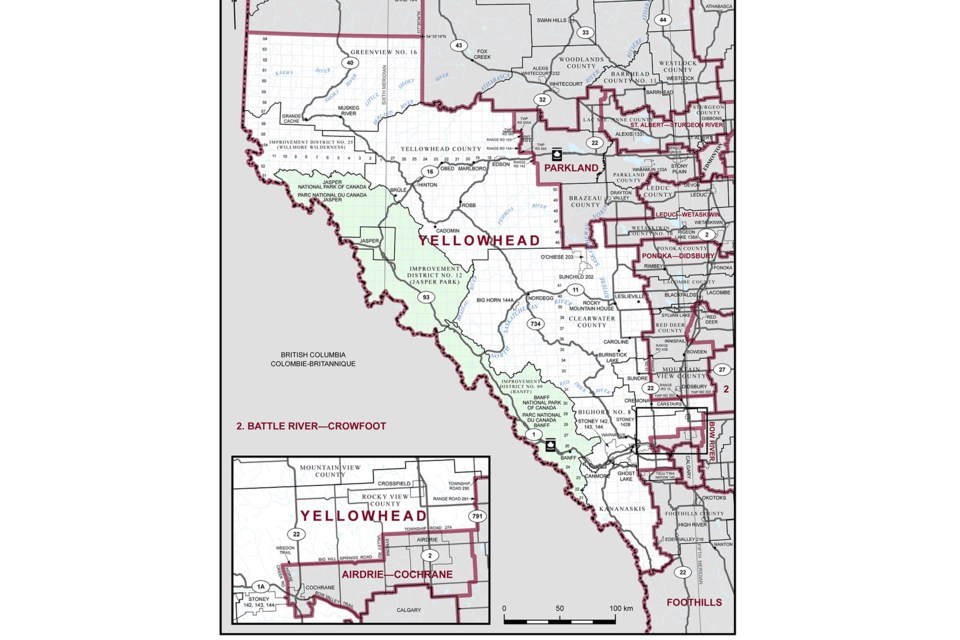JASPER – While the Yellowhead riding is projected to go blue this upcoming federal election, factors such as the new boundaries and tariffs are adding uncertainty.
Lori Williams, a political scientist at Mount Royal University, explained it remained unlikely that anyone but the Conservative candidate would have a chance in the riding, given how many constituents are farmers who want a representative who understands agricultural and rural life.
“That’s likely the kind of voice that’s going to dominate here, unless there’s a real surge in momentum for the Liberals,” Williams said, adding the more competitive Alberta ridings would be in Calgary and Edmonton.
The list of confirmed Yellowhead candidates includes Carstairs CPA William Stevenson (CPC), Jasper’s director of recovery Michael Fark (Liberal) and Canmore scientist and entrepreneur Avni Soma (NDP). There is also Vicky Bayford with the People’s Party and Dale Heath with the Christian Heritage Party.
The new Yellowhead riding, which stretches from Banff to Grande Cache, is one of the biggest geographically in Alberta.
Although acknowledging the size and diversity of Yellowhead, Williams noted that Alberta’s three major mountain towns are now in the same riding, which could give more impact to their voices and influence the race, especially since the Liberal candidate is associated with Jasper’s wildfire recovery.
The riding also has no incumbent due to the current MP Gerald Soroka losing the Conservative nomination to Stevenson last summer and Blake Richards, who is the long-time MP for the Banff, Canmore, Lake Louise, Kananaskis Country, MD of Bighorn and Stoney Nakoda part of the riding, running for the new Airdrie-Cochrane riding.
“That mixes things up a little bit,” Williams said. “I mean, polling suggests this is still safe for the Conservatives, but it could be a bit more interesting even now in the election, but certainly after the election in terms of the demands on the representative.”
Yellowhead is labelled as “CPC safe” with the Conservatives having a 99 per cent chance of winning and projected to win 68 per cent of the vote as of Thursday (April 17). Federally, the Liberals are forecasted to win 191 seats, and the Tories would be the runner-up with 123 seats.
Williams cautioned that polling only reveals what was happening at a given moment, but noted Liberal support was the highest it had been in Alberta since 1968, primarily because the party has picked up support from people who would normally vote for the NDP and Greens.
When it comes to Jasper, she explained that Stevenson may have an opportunity to critique the Liberal government’s response to the 2024 wildfire, which destroyed nearly a third of the townsite, as well as recovery efforts.
“Housing is a problem across the country, but it’s the biggest burden in Jasper,” she said. “As much as there are common threads that unite or join the [national] parks towns, Jasper’s a different matter and may be open to a different kind of message than it might have been before.”
Dissatisfaction with the UCP government for not delivering interim housing could also influence Jasperites’ decision at the polls.
“I see this a lot, actually, that people on a lot of issues don’t really care which level of government it is,” Williams said. “They want their governments, which they’ve elected at all three levels, to work together to solve the problems they’re facing, and for folks that have come through a crisis as they have in Jasper, I think this is even more the case.”
Other important issues for Yellowhead voters include affordability and the ongoing trade war, particularly since tariffs would affect many local industries such as agriculture and forestry.
“There’s a real sense of economic vulnerability, and again, that could open some people up to voting in a different way than they have in the past,” Williams said. “Polls aren’t suggesting enough to actually flip a seat, but this is a complex election.”
The federal election is slated for April 28.




